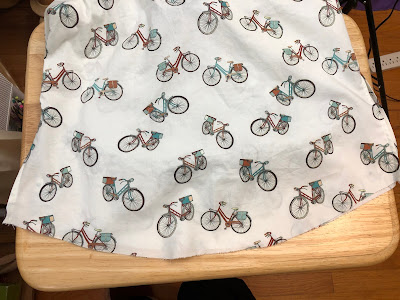As I was writing a review of the Sinclair Nova Raglan pattern for Pattern Review, I realized I never blogged not only about the specific pattern itself but also the Sinclair pattern in general. I have sewn four different patterns from said company and have a couple more in my stash and I really love everything I have made. Not only is the sizing spot on, Sinclair patterns cater to regular, tall and petite figures. I'll have to do better next time! For now, I am focusing on one of my favorite sweatshirt makes using the Sinclair Nova Raglan pattern.
The pattern itself is easy to sew and since the instructions are detailed, even beginners will be able to tackle it without much difficulty.
My first and third versions took advantage of the raglan style to colorblock and highlight some one of a kind fabric panel prints.
 |
| This was my first Sinclair Nova sweatshirt. I used a Marcy Tilton rayon jersey panel print for the front. |
 |
| For the rest (back, sleeves, cuffs, binding and band) I used cotton jersey from stash. |
 |
| In this more recent version, I also used a Marcy Tilton panel for the front. |
 |
| Then I had some fun combining prints and solids, some from my stash. |
 |
| For this second version, I used an animal print knit. To highlight the raglan cut, I added a solid colored binding along the raglan seams. |
What's amazing about this pattern is I didn't have to do any fitting alterations, not even the bodice length or sleeves! There are other neckline options included in the pattern (cowl and hood) and also the option to use drawstring on the bottom hem. I'll probably give one of those views a try next time because I'm sure there'll be a next time!
And now a look at the details on the most recent make:
 |
| Front view |
 |
| Back view |
 |
| I paired a printed cuff with the solid left sleeve. |
 |
| For the printed right sleeve, I opted for the solid cuff which was the same fabric used in the back. |
 |
| I used a blush pink cotton knit for the neckline binding and the bottom band. |
 |
| A closer look at the neckline. I used a triple cover stitch to topstitch. |
 |
| Serged cuff seam. |
 |
| Serging on the shoulder seam. Coverstitching on the neckline binding. |
 |
| Serging on the bottom band. |
 |
| I love the resulting asymmetry and the colors in this sweatshirt! I think right now, this is my favorite! |
If you are interested in a more detailed review of the pattern, check out my reviews
here and
here.





















































